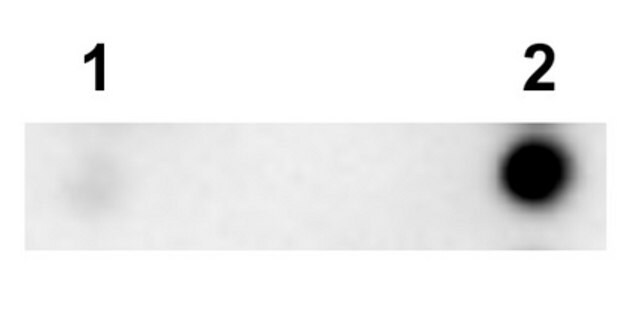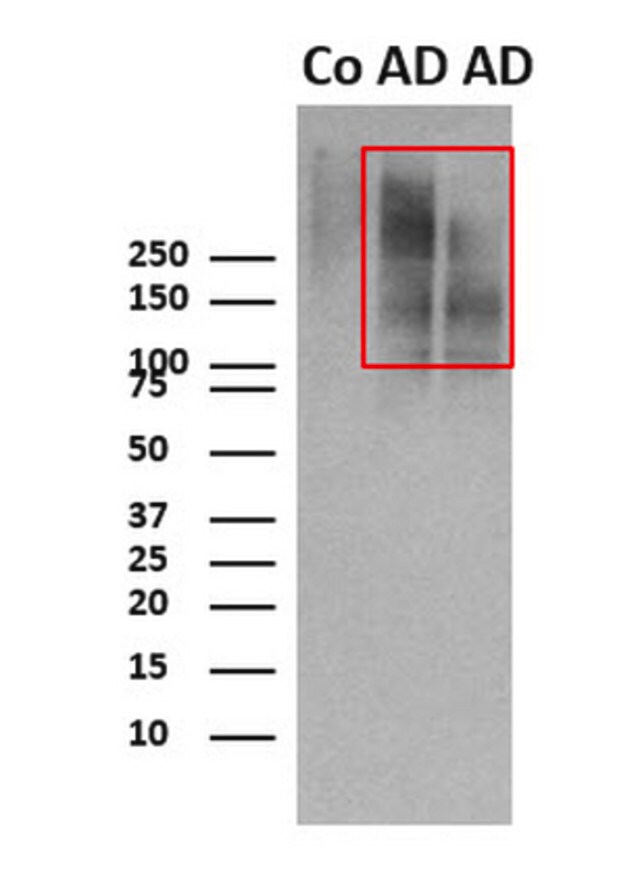您的位置:首页 > 产品中心 > Anti-Tau (T22) Antibody, oligomeric
Anti-Tau (T22) Antibody, oligomeric

| 产品编号: | 4093933 |
| 规格: | from rabbit, purified by affinity chromatography |
| 包装规格: | 100 μG |
| 产品类别: | 进口试剂 |
| 品牌: | Sigma-Aldrich |
| 优惠价: | 立即咨询 |
产品别名
Anti-Tau (T22) Antibody, oligomeric
Microtubule-associated protein tau oligomer, Tau oligomer, PHF-tau oligomer, Paired helical filament-tau oligomer, Neurofibrillary tangle protein oligomer
基本信息
| eCl@ss | 32160702 |
| General description【一般描述】 | Microtubule-associated protein tau (UniProt P10636; also known as Neurofibrillary tangle protein, Paired helical filament-tau, PHF-tau) is encoded by the MAPT (also known as TAU, MAPT1, MTBTL) gene (Gene ID 4137) in human. In Alzheimer′s disease (AD) pathology, accumulation of the microtubule-associated protein tau takes place primarily in the neurons. Tau accumulates in both the somatodendritic and axonal domains of neurons. Tau also accumulates in the soma as neurofibrillary tangles (NFTs). Cell death and synaptic lesions occur independently of NFT formation, and research indicates that NFT formation alone is insufficient for neurodegeneration, suggesting that soluble tau aggregates may be the more toxic and pathologically significant tau species. Tau oligomers are neurotoxic when applied extracellularly to cultured neuronal cells, and tau oligomers (but not fibrils) induce neurodegeneration and synaptic and mitochondrial dysfunction in vivo. Moreove, researchers are able to use tau oligomers as a reliable biomarker to differentiate AD brains from age-matched non-AD brains. |
| Specificity【特异性】 | T22 specifically recognizes and neutralizes oligomeric tau, T22 does not show any significant reactivity toward monomeric tau, tau fibrils, Aβ oligomers, Aβ fibrils, α-synuclein oligomers, or α-synuclein fibrils (Lasagna-Reeves, C. A., et al. (2012). FASEB J. 26(5):1946-1959). |
| Immunogen【免疫原】 | Recombinant human Tau-441 (Tau-F, Tau-4, 2N4R isoform) oligomers (Lasagna-Reeves, C. A., et al. (2012). FASEB J. 26(5):1946-1959). |
| Application【应用】 | This rabbit polyclonal Anti-Tau (T22), oligomeric, Cat. No. ABN454-I detects levels of Tau oligomers, and has been published and validated for use in Dot Blot, Immunofluorescence, Immunohistochemistry and Western Blotting. Western Blotting Analysis: 4-6.67 µg/mL from a representative lot detected tau oligomers in frontal cortex tissue lysates from Alzheimer′s diseased (AD), but not from age-matched non-AD, human brains (Courtesy of Prof. Rakez Kayed, University of Texas, Galveston). Dot Blot Analysis: A representative lot detected human P301S tau oligomers in hippocampal dentate gyrus (DG) and medial entorhinal cortex (MEC) tissue lysates from PS19 transgenic mice. Daily N-SMase Inhibitor GW4869 i.p. injection reduced tau oligomer accumulation in DG, but not MEC (Asai, H., et al. (2015). Nat. Neurosci. 18(11):1584-1593). Dot Blot Analysis: A representative lot detected increased tau oligomers formation in Alzheimer′s diseased (AD) as well as in aged non-AD human medial temporal gyrus tissue lysates (Blair, L.J., et al. (2013). J. Clin. Invest. 123(10):4158-4169). Immunohistochemistry Analysis: A representative lot detected human tau oligomers formation in paraffin-embedded striatal sections of Huntington s diseased brains (Vuono, R., et al. (2015). Brain. 138(Pt 7):1907-1918). Immunohistochemistry Analysis: A representative lot detected increased human tau P301L mutant oligomers formation in CA3 region of Tg4510 mice following FKBP51-expressing AAV viarl particles injection using 4% paraformaldehyde-fixed free-floating brain sections (Blair, L.J., et al. (2013). J. Clin. Invest. 123(10):4158-4169). Immunofluorescence Analysis: A representative lot detected granule cell layer (GCL) neurons containing oligomers of virally expressed human P301L mutant tau 1 441 by fluorescent immunohistochemistry staining of brain sections from mice received recombinant viral injection to the medial entorhinal cortex (MEC) (Asai, H., et al. (2015). Nat. Neurosci. 18(11):1584-1593). Immunofluorescence Analysis: A representative lot detected greatly enhanced tau oligomers co-localized with that of oxidative nucleic acid damage marker 8-OH(d)G in human AD brain, as well as heat stress- (HS-) induced Tau oligomers formation in the brain CA1 region of THY-Tau22 transgenic mice expressing human tau with G272V and P301S mutation by fluorescent immunohistochemistry staining of paraffin-embedded brain tissue sections (Violet, M., et al. (2015). Neurobiol. Dis. 82:540-551). Western Blotting Analysis: A representative lot detected human P301S tau oligomers-containing exosomal fractions from PS19 transgenic mice. Dietary supplementation with CSF-1R Inhibitor PLX3397 reduced exosomal tau oligomer accumulation (Asai, H., et al. (2015). Nat. Neurosci. 18(11):1584-1593). The unpurified antiserum (Cat. No. ABN454) is also available for dot blot, ELISA, immunofluorescence, immunohistochemistry, immunoprecipitation, neutralization, and Western blotting applications. Research Category Neuroscience |
| Quality【质量】 | Evaluated by Dot Blot analysis of recombinant human tau. Dot Blot Analysis: 2 µg/mL of this antibody detected 100 ng of in vitro generated recombinant human tau oligomers, but not tau monomer. |
| Physical form【外形】 | Affinity purified. Purified rabbit polyclonal antibody in PBS without preservatives. |
| Other Notes【其他说明】 | Concentration: Please refer to lot specific datasheet. |
产品性质
| biological source【生物来源】 | rabbit |
| Quality Level【质量水平】 | 100 |
| antibody form【抗体形式】 | affinity isolated antibody |
| antibody product type | primary antibodies |
| clone【克隆】 | polyclonal |
| purified by【纯化方式】 | affinity chromatography |
| species reactivity | human |
| technique(s) | dot blot: suitable immunofluorescence: suitable immunohistochemistry: suitable western blot: suitable |
| NCBI accession no.【NCBI登记号】 | NP_001116538 |
| UniProt accession no.【UniProt登记号】 | P10636 |
| shipped in【运输】 | ambient |
产品说明
| Target description【目标描述】 | Variable depending on the size(s) of the oligomer(s). Uncharacterized bands may be observed in some lysate(s). |
| Storage and Stability【储存及稳定性】 | Stable for 1 year at -20°C from date of receipt. Handling Recommendations: Upon receipt and prior to removing the cap, centrifuge the vial and gently mix the solution. Aliquot into microcentrifuge tubes and store at -20°C. Avoid repeated freeze/thaw cycles, which may damage IgG and affect product performance. |
| Disclaimer【免责声明】 | Unless otherwise stated in our catalog or other company documentation accompanying the product(s), our products are intended for research use only and are not to be used for any other purpose, which includes but is not limited to, unauthorized commercial uses, in vitro diagnostic uses, ex vivo or in vivo therapeutic uses or any type of consumption or application to humans or animals. |
安全信息
| Storage Class Code【储存分类代码】 | 12 - Non Combustible Liquids |
| WGK | WGK 2 |





